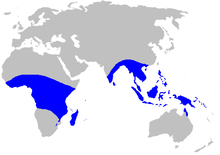Musaceae
| Musaceae Temporal range:
| |
|---|---|

| |
| Musa × paradisiaca | |
| Scientific classification | |
| Kingdom: | Plantae |
| Clade: | Tracheophytes |
| Clade: | Angiosperms |
| Clade: | Monocots |
| Clade: | Commelinids |
| Order: | Zingiberales |
| Family: | Musaceae Juss.[2] |
| Type genus | |
| Musa | |
| Genera | |

| |
Musaceae distribution
| |
Musaceae is a
Taxonomy
The family has been practically universally recognized by taxonomists, although with differing circumscriptions. Older circumscriptions of the family commonly included the genera now included in
The
The oldest fossil evidence of the family is thought to possibly be the
| Cladogram: Phylogeny of Zingiberales[8]
| |||||||||||||||||||||||||||||||||||||||||||||
|
Genera
As currently circumscribed the family includes three
Before 1753, the genus had already been described by the pre-Linnaean
In this clearing up of the taxonomy, Ernest Entwistle Cheesman in 1947 revived the genus name Ensete which had been published in 1862, by Horaninow, but had not been accepted.
Musa section Musella Franch. was raised to the rank of genus by H.W. Li in 1978 for the Chinese species Musella lasiocarpa, which was originally described in Musa in 1889 and transferred to Ensete by Cheesman in 1948. The species combines characters like the swollen stems of Ensete with the clonal habit of Musa. Acceptance of Musella has varied; as of February 2013[update], the World Checklist of Selected Plant Families considers it a synonym of Ensete,[12] other sources dispute this view.[3]
References
- ^ a b "Zingiberales". www.mobot.org. Retrieved 2023-06-18.
- hdl:10654/18083.
- ^ .
- PMID 30715125.
- .
- S2CID 231875495.
- JSTOR 2445709.
- ^ Sass et al 2016.
- ^ "Musa sapientum". users.globalnet.co.uk. Retrieved 11 January 2011.[permanent dead link]
- ^ "Musa paradisiaca". users.globalnet.co.uk.
- ^ Michel H. Porcher; Prof. Snow Barlow (2002-07-19). "Sorting Musa names". The University of Melbourne. Retrieved 11 January 2011.
- ^ "Musella", World Checklist of Selected Plant Families, Royal Botanic Gardens, Kew, retrieved 2013-02-07
Bibliography
- Sass, C; Iles, WJ; Barrett, CF; Smith, SY; Specht, CD (21 January 2016). "Revisiting the Zingiberales: using multiplexed exon capture to resolve ancient and recent phylogenetic splits in a charismatic plant lineage". PMID 26819846.
External links
- Preliminary analysis of the literature on the distribution of wild Musa species Archived 2008-10-11 at the Wayback Machine
- Musaceae at the Angiosperm Phylogeny Website
- Musaceae in the Flora of China
- Musaceae Archived 2007-04-05 at the Wayback Machine in L. Watson and M.J. Dallwitz (1992 onwards). The families of flowering plants Archived 2007-01-03 at the Wayback Machine: descriptions, illustrations, identification, information retrieval. Version: 27 April 2006. http://delta-intkey.com Archived 2007-01-03 at the Wayback Machine.
- Monocot families (USDA)
- NCBI Taxonomy Browser
- links at CSDL Archived 2007-05-17 at the Wayback Machine
- The Musaceae - an annotated list of the species [1]
 Media related to Musaceae at Wikimedia Commons
Media related to Musaceae at Wikimedia Commons Data related to Musaceae at Wikispecies
Data related to Musaceae at Wikispecies
